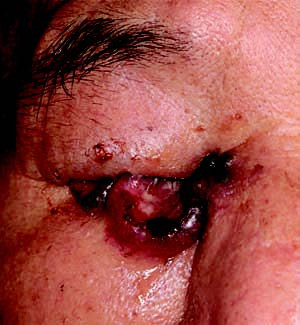Squamous cell carcinoma of the eyelid typically occurs in middle-aged and elderly individuals, most commonly at the mucocutaneous junction of the eyelid margin. In the early stages, it resembles a papilloma and grows slowly, with patients usually not experiencing discomfort. As the disease progresses, the lesion gradually develops into an ulcer with slightly raised, firm edges, which may lead to necrosis and secondary infection. In some cases, squamous cell carcinoma exhibits perineural invasion, which is associated with significant pain. The tumor demonstrates relatively rapid growth and a high degree of malignancy, with the potential to invade subcutaneous tissues, the tarsal plate, the ocular surface, and the orbit. It can metastasize to local lymph nodes, such as the preauricular and submandibular lymph nodes, and even to distant organs.

Figure 1 Squamous cell carcinoma of the right eyelid
The tumor exhibits rapid progression, invading the full thickness of the eyelid, the orbit, and the globe.
Treatment
Surgical treatment is the primary approach, with intraoperative pathological examination used to determine the excision margins.